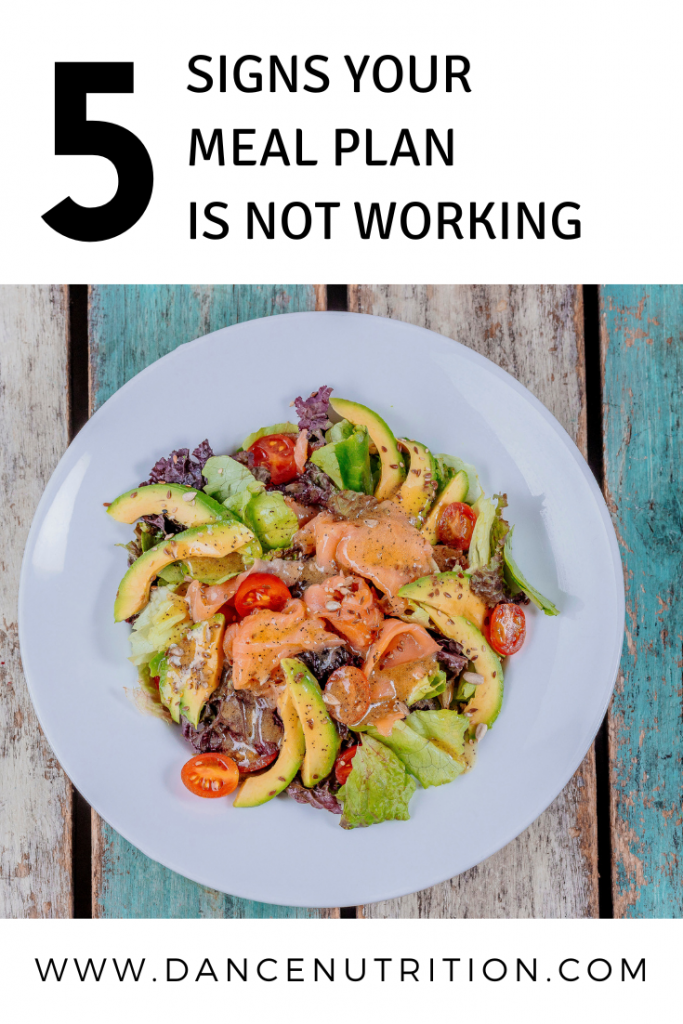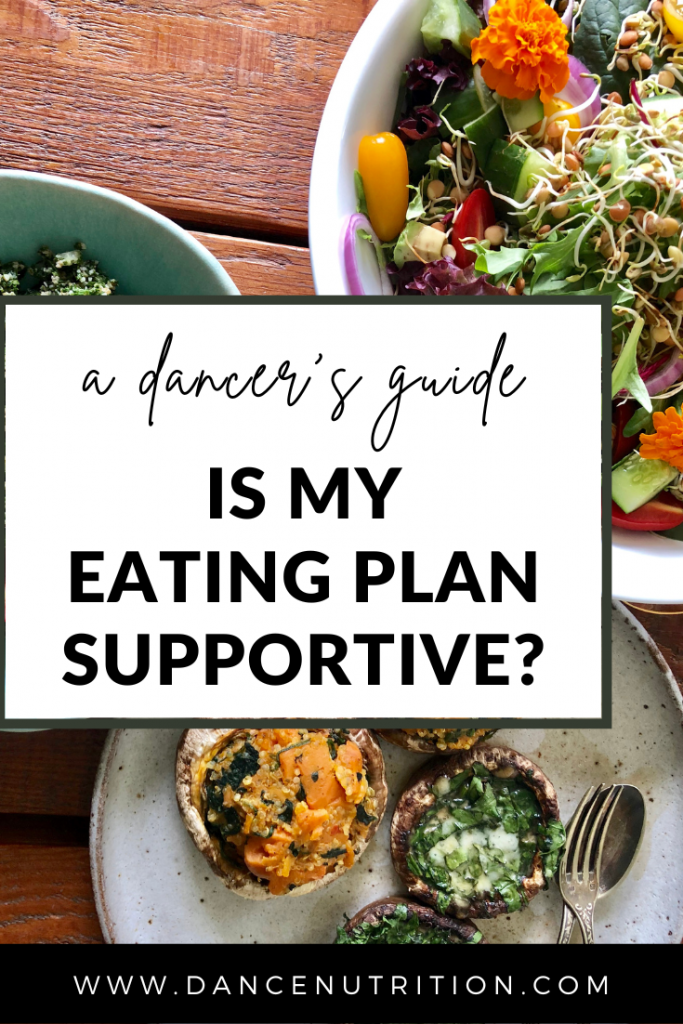Many dancers struggle to figure out how, when, and what to eat to support their training. With so much nutrition misinformation online, it’s easy to fall into unsustainable eating habits — like following strict calorie counts or cycling between “being good” and feeling like you’ve “overdone it.”
If you’re wondering whether your current meal plan is truly supporting your dancing, there are specific red flags to look for. Once you spot them, you’ll be better equipped to rebuild your eating routine into one that fuels your energy, performance, and recovery — without the guilt.
Let’s uncover the five most common meal plan pitfalls among dancers and how to fix them.
#1: You’re Feeling Drained on Non-Dance Days
Dancer meal plan solution: Despite misconceptions about eating less when moving less, it’s normal to experience increases in your hunger cues on rest days; honor them. Additionally, map out a flexible eating routine for your busy days that prioritizes regular eating times (aim for a meal or snack every 2-4 hours depending on your schedule and activity level). But time constraints make this challenging, so plan emergency snacks (here’s a complete snack guide to get started).
First, let’s acknowledge the win: you’re resting. Rest days are essential for a strong, sustainable dance career. However, if you notice that every rest day leaves you feeling more sluggish than restored, your current eating routine may not be meeting your needs.
Dancer meal plan pitfall:
Busy rehearsal days can make it easy to under-fuel without realizing it. When you finally get a rest day, your body is often playing catch-up, leading to fatigue, brain fog, and even mood changes.
#2: You’re Always Hungry
Hunger cues can be confusing for dancers. Between long hours, cross-training, and multitasking, it’s easy to miss early hunger signs. If relying on hunger pangs alone, you might experience intense cravings or overeating later in the day.
Sometimes, constant hunger isn’t just about missed meals. It can also signal imbalanced eating. For example, cutting back on fats or carbs in an effort to “eat lighter.” But both are essential for satiety, endurance, and hormonal health.
Dancer meal plan pitfall:
You’re under-eating overall, or restricting foods like carbs and fats that are vital for satisfaction and energy.
Dancer meal plan resolution:
Build staying power into each meal:
- Combine carbohydrates (for energy)
- Protein (for repair)
- Fat (for fullness)
For example: oatmeal topped with peanut butter and berries, or pasta with olive oil, chicken, and veggies. These combinations support longer-lasting energy and fewer energy crashes mid-rehearsal. Learn more in How to Build Balanced Meals for Dancers.
#3: You’re Overly Worried About Your Food Choices
If food decisions dominate your thoughts — questioning whether a snack is “clean” enough or feeling guilty after certain meals — that’s a sign your meal plan has crossed into restrictive territory.
Clean eating may appear “healthy,” but for dancers, it often becomes a gateway to disordered eating. The more foods you label as “good” or “bad,” the smaller your safe food list becomes and the more stress you attach to eating.
Dancer meal plan pitfall:
Obsessing over the “right” foods leads to mental burnout, guilt, and fear of eating outside your comfort zone, especially when those options are deemed “clean,” acceptable, or unavailable.
Dancer meal plan resolution:
Your performance and health come from patterns over time, not perfection at each meal. Practice inclusion, not exclusion.
Try The Healthy Dancer® Food Flexibility Algorithm:
- Start with your craving or available food.
- Add a nutrient boost (protein, fiber, or fat).
- Eat, reflect, and move on — no overthinking required.
#4: You’re Setting Unrealistic Expectations
Meal planning doesn’t have to look like a Pinterest-worthy lunchbox. Dancers often get stuck in all-or-nothing thinking, either cooking from scratch every day or feeling like they’ve failed when life gets busy.
Dancer meal plan pitfall:
You’re chasing the “perfect” meal prep aesthetic instead of building a routine that’s actually doable.
Dancer meal plan resolution:
Simplify. Spend 5–10 minutes planning ahead for the week, but allow room for flexibility. Convenience foods can be part of a balanced routine:
- Add frozen veggies to pasta
- Top oatmeal with pre-cut fruit
- Pair hummus packs with chips or pretzels
- Keep protein bars and trail mix in your dance bag
Shortcuts aren’t lazy! They’re strategic tools that make consistent fueling possible. Get more ideas in A Dancer’s Guide to Meal Planning.
#5: You’re Following a One-Size-Fits-All Approach
No two dancers train, recover, or metabolize food in the same way. Yet many follow generic plans pulled from social media, peers, or influencer “what I eat in a day” videos, and end up wondering why they’re exhausted or stuck.
Dancer meal plan pitfall:
You’re following a plan that worked for someone else, not recognizing that your needs are unique to your body, training load, and goals.
Dancer meal plan resolution:
Nutrition isn’t one-size-fits-all. If you’ve tried to adjust your eating routine but still struggle with low energy, irregular hunger, or stress around food, working with a Registered Dietitian Nutritionist (RDN) who specializes in dancers can help.
Together, you can identify what’s missing, rebuild balance, and create a flexible plan that works with your life, not against it. Here are a few helpful articles to consider when formulating an eating routine that works:
- How many calories do I need?
- What should my cross-training routine look like?
- How can my relationship with food help me, not hinder me?
Key Takeaways
If your meal plan leaves you drained, hungry, or stressed about food, it’s not you; it’s the plan. The goal isn’t to eat perfectly, but to eat consistently and confidently in a way that fuels your performance and supports your well-being both in and out of the studio.
Small, sustainable changes — such as eating regularly, adding balanced snacks, and letting go of rigid food rules — can make a meaningful difference in how you feel in your body and your dancing.
If you’re ready to build those habits with guidance, accountability, and a supportive community that understands the unique demands of dance, The Healthy Dancer® Membership can help. Inside, you’ll find step-by-step lessons, meal ideas, coaching, and tools designed to help you feel your best.




